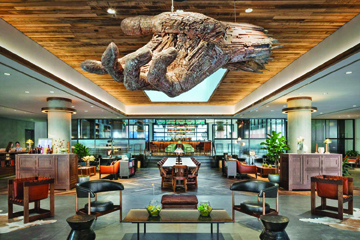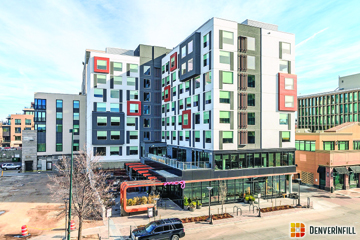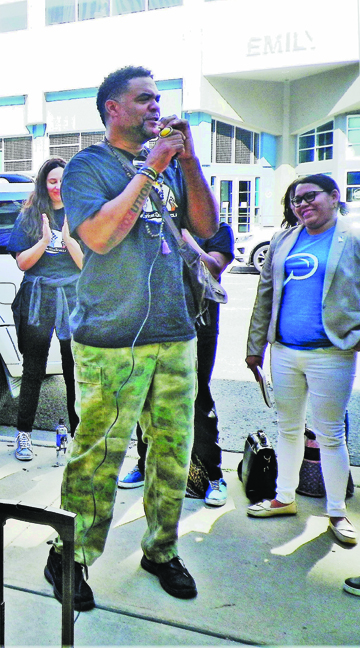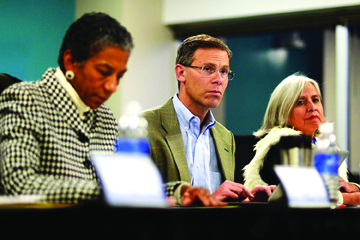
by Mark Smiley | Aug 24, 2018 | General Featured
(BPT) – Dreaming of an Italian vacation? You can experience the country’s stunning, ancient and romantic regions without even leaving home. The wines of Italy embody the heart and soul of the country itself, being a part of the land, the air and the water of the regions in which they’re grown.
Letting the vineyards be your guide, you’ll travel from the Tuscan coast to the Adriatic’s long, sandy beaches, to the black and rich slopes of an active volcano. You’ll marvel at Sicily’s crystal blue waters and be awed by Campania’s storied past. You can even learn about some dedicated winemakers along the way.
Invite your friends for a backyard wine tasting on a balmy evening, open up these Italian whites, and enjoy their not-commonly-known varieties accompanied by light, Italian fare. Buon viaggio!
Ca’Marcanda Vistamare: The playful name of this wine, which means “sea view,” was inspired by the Tyrrhenian sea breeze, the sun and the cheerful, lighthearted outlook of the Tuscan coast. Coastal innkeepers would use “vistamare” to entice hotel guests, even if their rooms only offered a limited view of the Mediterranean. The vineyards used for Vistamare actually enjoy a panoramic view of the Tuscan horizon, and their grapes are gently touched by the salt air and brilliant colors of the Tuscan sea.
Vistamare is fresh and light on the palate, with notes of bergamot, pear and nectarine. Then it shifts toward a more mineral and spicy character, with notes of flint, rosemary and saffron. The wine gets riper in the finish with hints of mango.
Terlato Vineyards Colli Orientali del Friuli Friulano: Travel to Northern Italy’s Friuli region, where mountains overlook the Adriatic Sea, its coastline dotted with lagoons and long sandy beaches. Friulano is the predominant wine here because of the ideal growing conditions for this indigenous varietal. This Friulano comes from very old vines located on Estate vineyards at 1,050 feet above sea level, with cool nights and warm days, ideal for producing wines with excellent acidity and elegance.
Attention to detail gives the wine floral aromas with distinct pear and almond notes, and a creamy, full-bodied texture.
Anselmi San Vincenzo: Grown in the Monteforte area within the Veneto region of Northern Italy, San Vincenzo vines are planted on 110 acres of volcanic tuff and limestone. Veneto is encircled by Lake Garda, the Dolomite Mountains and the Adriatic Sea. Imagine floating down the Grand Canal in Venice, and seeing Juliet’s balcony in Verona before finding a cafe where you can sip this delicious wine of the region.
San Vincenzo is medium bodied and fruit forward, with a clean, dry finish and scents of minerals, lemon, lime and melon.
Alta Mora Etna Bianco: Travel south to Sicily, the largest island in the Mediterranean Sea, where these grapes are grown and harvested on the slopes of the active volcano, Mount Etna. The soil is black, fertile and dynamic, and the name Alta Mora translates to “tall, black,” representing the great heights of the vineyards on the mountain and the dark, black volcanic soil.
This wine is a slight nod to Sauvignon Blanc in style. It’s fresh and fruity, with great minerality, and a classic match for seafood dishes. It’s easy to imagine sipping it while gazing out onto the Mediterranean’s crystal blue waters.
Feudi di San Gregorio Falanghina: This vineyard is in Sorbo Serpico, a tiny village in Campania’s Irpinia region, near Mount Vesuvius. The area, with its numerous castles and fortresses, has ancient roots, and has been a transit land between the Tyrrhenian and Adriatic seas. Named after the method of vine cultivation in Sannio at the end of the Roman Era called Falangs (“poles”), this Falanghina is ideal as an aperitif. It can also accompany various types of appetizers, plates of simple fish and vegetables as well as fresh cheeses.
Floral notes like white blossoms and delicate apple and pear float through the air as you sip this medium intensity wine, which is crisp with hints of spice, light almond and a slightly bitter orange peel character.
Let these wines bring the beauty of Italy to your table tonight. Cincin!

by Mark Smiley | Aug 24, 2018 | Feature Story Bottom Left
Show In New Colfax Space Has Stunning Photomontages, Exquisite Geometric Images Plus Paintings, Glass Sculpture
 Reopening on East Colfax in June, the Robert Anderson Gallery will debut its second show in the new space Sept. 14 with an opening reception from 5 to 8 p.m. On display through October, the exhibition is featuring the unique photomontage work of Patti Barry Levy, the exquisite geometric images of Lauri R. Dunn, and the striking paintings and glass sculptures by Ana Maria Botero. Located in Cherry Creek for several years, the galley reopened in a much larger space at 3321 East Colfax adjacent to the historic Bluebird Theater.
Reopening on East Colfax in June, the Robert Anderson Gallery will debut its second show in the new space Sept. 14 with an opening reception from 5 to 8 p.m. On display through October, the exhibition is featuring the unique photomontage work of Patti Barry Levy, the exquisite geometric images of Lauri R. Dunn, and the striking paintings and glass sculptures by Ana Maria Botero. Located in Cherry Creek for several years, the galley reopened in a much larger space at 3321 East Colfax adjacent to the historic Bluebird Theater.
The apparent emptiness of the grasslands east of artist Patricia Barry Levy’s Denver home hints at intriguing tales, possible and impossible scenarios. With degrees in history and photography she has been using her computers to make images since 2005. Show attendees will see how she uses photomontages to merge reality and fantasy to tell stories that give viewers a voyage into the imagination. Viewers will be equally entertained by the geometric images of artist Lauri R. Dunn. With a BFA in Photography from Maryland Institute’s College of Arts, she teaches art in Jefferson County Public Schools.
Also on display are striking paintings and glass sculptures by Ana Maria Botero. A wife, mother, architect and artist, she was born in Bogotá, Colombia, where she lived and worked as an architect until 2001 when she relocated to Florida. Moving to Colorado in 2015 she started painting. Although she still loves architecture, her hobby is now her passion. Also on display will be selected vintage images by Carleton Watkins, Nick Brandt and others. Information: 303-257-0684.
Landscapes-Garden Show
Old South Gaylord’s popular gallery Arts at Denver is showing the work of four guest artists in September. The exciting show titled “American Fauves: the Wild Ones,” features American Landscapes and Gardens.
Three are out-of-state artists plus Colorado’s David W. Mayer from Lafayette. The other artists are Erin Hanson from California, Cynthia Rosen from Vermont, and Heather Arenas from Florida.
Attendees will discover the contemporary im pressionism oil painting of California-based Hanson. She developed the Open Impressionism movement that is now taught in art schools worldwide. Also on display will be work by gallery artists Michael Clark and Margaretta Caesar. Information: 303-722-0422.
pressionism oil painting of California-based Hanson. She developed the Open Impressionism movement that is now taught in art schools worldwide. Also on display will be work by gallery artists Michael Clark and Margaretta Caesar. Information: 303-722-0422.
Antique Maps & Prints
Cherry Creek North’s Philadelphia Print Shop West has relocated from Fillmore St. to 2830 E. 3rd Ave. The new location is on the 2nd floor of the building housing Cherry Creek Framing where they share space.
Visitors can browse through a collection of more than 10,000 antique maps and prints. There is also an array of related reference works, rare plate books and atlases.
Owner Christopher W. Lane was a partner in the Philadelphia Print Shop until he moved to Denver when his wife, Dr. J. Lindsey Lane, took a job at Children’s Hospital. He continues to appear as an expert appraiser on the PBS program Antiques Roadshow. Information: 303-322-4757.
Quick Sketches
The Truth of Nature, the biggest Claude Monet exhibit in decades, is coming to the Denver Art Museum in October 2019.
* * *
CRUSH — the largest independent graffiti and street art project and event in the Valley — is recipient of the Arts & Culture Innovation Award. Founded by Denver graffiti artist Robin Munro, CRUSH has been on the streets of the RiNo neighborhood since 2010. Originally centered within the EXDO Event Center, the event relocated three years ago to the long alley between 26th and 27th St. and Larimer and Walnut St., n ow dubbed Art Alley.
ow dubbed Art Alley.
* * *
The Art Institute of Colorado closed Aug. 28 eliminating 160 jobs. The school on Lincoln St. was among 50 being shut down nationwide. The campuses have been sold to an affiliate of Los Angeles-based Pentecostal organization.
* * *
The largest gift of European Old Masters since receiving the Kress Collection in the 1950s has been donated to the Denver Art Museum. The donation of British masterworks is from the Berger Educational Trust. The donation of 65 works will enhance the North Building set to reopen in 2021.

by Mark Smiley | Aug 24, 2018 | Main Articles
Denver Is Experiencing A Hotel Boom With Openings, Expansions And Renovation
by Glen Richardson

Super Size: This 1,500-room megaplex being built near DIA will be the state’s largest hotel. The sheer size of the Gaylord Rockies Hotel is likely to alter the Valley’s hotel, convention and spa landscape.

Cool Hand Hotel: The 3,600-sq.-ft. lobby of the Maven Hotel creates a seamless flow between work and play while serving as a neighborhood hub.
Denver is experiencing a hotel boom ignited by record-breaking occupancy that is escalating expansion and renovation in dozens of Valley neighborhoods. Moreover the upward trajectory in construction is forecast to continue despite some hiccups in recent months.
“In our lifetime, we’ve never seen this kind of demand, and it’s not slowing down,” MGM Grand’s Michael Dominguez told a meeting-convention group at Cherry Creek’s Halcyon Hotel this summer. Denver’s hotel occupancy rate of 73.7% is far above normal and nearly eight percentage points higher than the national average of 66%. Dominguez warns, however, that hotels are limiting service. “Nobody is building ballrooms.”
Denver’s hotel supply is forecast to increase by 4.6% this year, well above the 2% increase that is expected nationally. The 201-room Jacquard Hotel in Cherry Creek North is expected to finally open by September, bringing to five the number of hotels in the 16-block district. The 233-room Hilton Garden Inn Union Station is likely to be the next downtown hotel to open. By year’s end the megaplex 1,500-room Gaylord Rockies is scheduled to debut off of Pena Blvd. near DIA. Due to its sheer size it is almost certain to alter the Valley’s hotel, convention and spa landscape.
Growth Above 5%
Like Denver, hotel properties in other smaller cities such as Tampa, Charlotte, Phoenix, and Portland, are doing well. These are places where demand typically outpaces new construction and occupancies are at or near record high. Denver’s occupancy rates normally average around 65% over most 12-month periods. The 12-month occupancy rate in Denver is now more than 80% according to hotel research from CoStar Commercial Real Estate.
Demand for hotels in Denver is expected to grow 5.1% during 2018, pushing occupancy to new highs. Not only is demand expected to continue increasing this year but also through next year at more than twice the national average.
A total of 31.7 million visitors came to the Mile High City in 2017, a new record and the 12th consecutive year of growth. Denver gets only about 20% of the state’s visitors but accounts for half of all in-state tourism spending. Revenue last year was $6.5 billion. To be sure, the Valley’s abundant sunshine and outdoor recreation get a great deal of credit. Nevertheless — just as with the apartment boom — the so-called “green rush” of cannabis fans are luring a significant number of the city’s tourists, including mountain traffic headed to Denver hotels.
Third In Nation
Developers had 4,100 new hotel rooms under construction in 2017, ranking it fourth busiest city for hotel development. This year STR Hotel Market Data says there are 4,672 new hotel rooms under construction, ranking Denver third in the nation for most new hotel construction. Current U.S. leader

Creek Cool: Cherry Creek’s new Moxy Hotel adds a bright splash along Josephine St. The metal screening and random wood panels give this project a unique touch.
s are Nashville and Seattle.
“I think it’s almost impossible to say that Denver isn’t experiencing a hotel boom at the moment,” say residents who aren’t sure why. Others proudly proclaim Denver is becoming a very big U.S. tourist market because “what’s not to love about this city?”
Across Denver’s developing neighborhoods boutique hotels, like the Born, Maven and Moxy, are redefining the hospitality industry and filling a niche in a wide-ranging construction boom that is bringing dozens of new hotels and thousands of guest rooms to the city. The new aim developers say “is to lure travelers and entertain locals at the same time.”
Social Hubs
Hotels being built here now are becoming social and entertainment hubs, calling for flexible public spaces that provide a destination for travelers while also assimilating into the city’s local culture and its diverse neighborhoods. The building and interior, developers say, should be inviting yet uncommon enough to transport people from their daily routines.
Builders are working with art curators from the beginning of a pro

Ramblin’ Rose: One-of-a-kind touches include a custom, hand-carved hardwood front door make the new-yet-old-looking Ramble Hotel at 25th and Larimer a sparkling space.
ject to ensure art integrates fully into the design, instead of being an after-thought. That was the case with the recently opened Moxy Hotel in Cherry Creek. With 775 artworks and objects incorporated throughout the 170-room hotel, there’s a new surprise around every corner. The design and art work together to enhance the fun and funky millennial-minded concept that emphasizes social interaction. A boutique concept by Marriott, the building infuses the character of the surrounding upscale neighborhood while staying true to its “heart of a hostel” mindset.
The 50-room Ramble Hotel housed in a new-yet-old-looking brick building at 25th and Larimer is another case in point. Ryan Diggins of Gravitas Development Group added one-of-a-kind touches include a custom, hand-carved hardwood front door, chicken-wire glass from Rockefeller Center, and a grand lobby bar built by local craftsman Brian Trybus. Furthermore, LA’s Avenue Interior Design incorporates elegant furnishings, fabrics and accessories. At Sage Hospitality’s 172-room

Hybrid Hip: A trio of developers wants to build a hybrid hotel in RiNo, with 161 units renting for as short as a night or as long as a year.
Maven Hotel in the Dairy Block public space has been taken to an imaginative artistic level. The hotel’s 3,600-sq.-ft. lobby creates a seamless flow between work and play while serving as a neighborhood hub. It connects two eateries to an adjacent office building and can also serve as an adaptable event space or a vendor alley while also providing numerous dining options. Guest rooms feature a rich color palette and loft-style décor with high ceilings and large windows.
What’s Next?
A trio of local developers is proposing a hybrid residential complex in RiNo, with 161 units renting for as short as a night or as long as a year. Peak Development Group, Slipstream Properties and Kaplan Cos. want to build the yet-to-be-named eight-story project on Walnut St., a short walk from the 38th and Blake light rail station. Some floors would have units rented on a nightly or weekly basis, the companies say. Units on the remaining floors would be for more long-term tenants. The units would be a mix of studios and one-bedrooms, ranging in size from 350 to 650-sq.-ft. The three firms purchased the 0.32-acre triangular parcel at 3724 Walnut St. for $2.1 million in June. The parcel includes a two-story building, constructed in 1890, that the developers plan to preserve, with new construction flanking it on both sides. They’ve since spent another $1.1 mill

Spring Elements: Marriott is building the Element Hotel with restaurant at 14th Ave. & Elati that’s expected to open next spring.
ion on two adjacent parcels.
The Rossonian — an unoccupied Five Points landmark — will be renovated into a 41-room boutique hotel, complemented by a basement jazz club and ground floor restaurant-lounge. The eatery-bar venue will be named Chauncey’s for Denver basketball legend and project partner Chauncey Billups. Developer Paul Books plans to add a fourth floor, housing seven rooms and balconies on top of the existing three-story building. Palisade purchased the hotel in August for $6 million.
Here are a few other new hotels currently on the drawing board: Element Hotel by Marriott is building a 157-room studio, 1 and 2-bedroom inn with restaurant that’s expected to open at 14th Ave. and Elati next spring. Plans have been filed to build a 150-room Ballpark Hotel at 2250 Blake St. Also a 546-room Focus Hotel is slated for a 2021 debut at 14th and Stout. Finally, GFI Development is planning to build an Ace Hotel on 19th Ave. between Grant and Logan.

by Mark Smiley | Aug 24, 2018 | Main Articles
by Ruthy Wexler

Your DPS School Board Having Fun: Left to right: Barbara O’Brien, Lisa Flores, Jennifer Bacon, Allegra “Happy” Haynes, Carrie A. Olson PhD, President Anne Rowe, and Angela Cobian. “We need to find a wonderful leader,” says President Rowe, “to take this district forward” — a goal with which no one disagrees. But the way to that goal is not obvious. Even longtime pro-reform supporter O’Brien admits, “What is hard about this work, is that we can all imagine a great outcome … but we’re not sure how to get there.”
Over his 10-year reign, Denver Public Schools (DPS) Superintendent Tom Boasberg gained national prominence by his zealous implementation of reform educational measures. In recent years, opposition to those measures has grown — which is why, when Boasberg announced on July 17 that he was stepping down, over 22 local groups swung into action and collaborated on a Community Manifesto that, among other items, proclaimed their right to help select the new superintendent.
On July 30, at the first public meeting addressing the “super search,” the seven-member DPS School Board seemed to agree that community input was essential. “We are listening; keep those emails coming,” said new Board member Carrie Olson, as the other six nodded agreement. But their cheerfully united front masked the fact that this Board, with their divergent beliefs, wil

Activist: One of the activists who signed the Community Manifesto and delivered it on July 27 was Kerrie Joy, whose poem about community strength in education elicited cheers. “We are listening,” she proclaimed, “but we will also be heard.”
l soon face the central, inescapable question: Should they choose a candidate who will continue Boasberg’s policies? Or should they choose someone who wants to lead from a different direction?
Reform Or Not Reform: That Is The Question
Denver schools were widely believed to be failing when DPS Superintendent Michael Bennett began radically changing the city’s educational system with reform measures like welcoming charters, closing schools and using high-stakes testing to shape decisions. “We thought we were creating a system that served students first,” recalls Theresa Pena, School Board member from 2003-2011, who has recently written of her disappointment in DPS results.
When Bennett was picked to fill a U.S. Senate seat in 2009, the Board chose Boasberg to continue his policies.
But 10 years later, the main question — have reform policies achieved their stated goal of closing achievement gaps between low-income and more affluent students? — has no clear answer. In a district where students of color comprise almost three-quarters of the population, the answer depends on whom you ask. Observing recent data that shows DPS’s achievement gaps still gaping widely, Pena believes the district hasn’t gone far enough, while grassroots groups like Our Denver Our Schools (ODOS) and Our Denver Our Voices (ODOV) believe DPS resources should now go to improving neighborhood schools. Van Schoales, CEO of the pro-reform group A+ Colorado, says, “Going back to the way things were would be a huge mistake.”
Changing the makeup of the School Board is the only way citizens can affect change. This past election saw two candidates critical of the district’s current strategies, Olson and Jennifer Bacon, win seats on a previously all-reform board.
If You Wanna Be Superintendent …
On August 3, the Board passed a resolution, saying that the search would be internal as well as external (fueling rumors that Susanna Cordova, who once subbed for Boasberg, might be chosen); announcing the search’s timeline (candidates must submit applications by September 14; the Board will name finalists by October 15); and stating that an outside consultant would be used. On August 13, DPS hired the Illinois-based firm of Hazard, Attea & Associates, contracting to pay them $30,000 plus expenses.
Community, Speak!
Anxious that the tight timeline might prevent their voices from being heard, many teachers and parents shared with this reporter what they wanted in a new superintendent. The most frequently expressed opinion was that he or she be an educator. “They say the best manager is someone who knows the industry,” said ESL teacher Lisa W. “Well, the industry in teaching is … teaching.”
Sarah Dieter, a first grade paraprofessional, wanted, “… someone who has actually taught in a classroom under these budgetary and other restrictions.”
“Only an experienced teacher understands the beautiful complexities of learning,” said Andrea, who teaches Language Arts.

Breaking Our Chains: Among the educational activists who collaborated on the Community Manifesto is “Soul” Asemu, who stated, “Education is the civil rights issue of our time.” Asemu is the Executive Director of Breaking Our Chains, an organization which “focuses on supporting underserved students of color.”
One DPS father: “Businessmen have no business being superintendents.” History teacher Troy Valentine: “It’s not helpful when people with business degrees supervise teachers.”
“We want someone who gives educators confidence to use their common sense,” said DPS parents Gina and Mark O’Brien, whose six-year-old son’s classroom became overheated from a faulty valve, but, “No one would fix it, because it wasn’t next on the list.”
“Someone who views teachers as the foundation,” said first grade teacher Suzanne Hernandez.
“The new superintendent should insist on well-trained teachers and then trust those teachers to understand the needs of their students,” said Amy Turino, a 16-year veteran who now coaches colleagues.
Kindergarten teacher Julie W.: “Someone who really wants that job! Not as a stepping stone into politics. A wonderful job for an educator to use all they know. A woman, if possible.”
DPS parent Debby Thornburg James: “I want the new superintendent to LOVE public schools, so that she or he can immediately begin restoring them in every Denver neighborhood where charter schools now squat in our publicly owned school buildings.”
Councilwoman Deborah Ortega, whose grandchildren attend DPS: “Someone not so wrapped up in testing …”
Principal Sheldon Reynolds suggested that the new superintendent should, “… build on structures developed by Tom [Boasberg] over the past decade rather than dismantle them … The challenge is how do you honor the work (policies and practices) from Tom’s era while crafting a new vision [that would correct] … unintentional consequences of the prior work…”
Promises, Promises
“When I read that Boasberg was stepping down,” Ortega recalls, “I re

Unpopular Leader: The widely unpopular Superintendent of the Denver Public Schools Tom Boasberg, center, stepped down in July 2018 after 10 years at the helm. The last year has been riddled with controversy which some say prompted his resignation.
alized, ‘The community needs to impact this decision.’” The Community Manifesto she helped facilitate, signed by dozens of local organizations and individuals, asks that the new superintendent be “a transformer, not a reformer.” The document was delivered on July 27 to the Board, which so far, has not mentioned it.
The DPS board has the responsibility of choosing Boasberg’s replacement — and thus, the future of Denver’s 92,600 students. The community, says James, “… has been promised the opportunity to give input into this decision, which affects our children most of all. We are waiting.”

by Mark Smiley | Aug 24, 2018 | Glendale City News
Glendale Team Will Be Bigger And Better Starting This Fall
by John Arthur
Writer for and on behalf of the City of Glendale

Glendale Raptors Head Coach David Williams, right, answers questions in a post match interview with Nate Kreckman, left, up in the VIP Raptors Club after a Major League Rugby victory at Infinity Park. (Photo by Seth McConnell)
Following a statistically impressive but ultimately disappointing conclusion to their inaugural Major League Rugby debut season, the Glendale Raptors have all hands on deck for 2019. As an exhibition schedule and official preseason loom ever nearer, Raptors Head Coach David Williams explains how hard his side is working to make sure the MLR Championship Shield comes to Glendale next year.
After a short July break, the Raptors are back to regular season training levels. With a focus on what Williams puts simply as “building bigger, better, more powerful bodies,” the squad is hitting the gym five days a week. Off-season preparation is focused on individual development, skills improvement, and patterns. With a reasonable timeframe to get into shape before league play starts, the Raptors should be able to integrate new talent onto the squad and prepare the players being called up to the USA Eagles side for the national team’s four-game November tour.
Long characterized by veteran players, the Raptors are not short on opportunities to recruit new talent. Infinity Park hosted a camp for the Collegiate All-Americans in mid-August, an event that saw nearly one hundred of the best college-level rugby players in the country come to compete. Split divisionally, East and West, the group was pared to the top selections, later playing against the Raptors MLR side. Glendale Head Coach Williams explains that the camp is a recruitment tool: “It doesn’t just give us a shot at early pre-season play, it also allows our coaching staff and the rest of the MLR coaches a chance to see the next generation of talent in action.” Outside of U.S. potentials, international signings within the league point to the talent that MLR is attracting, and add further value and legitimacy to American professional rugby.
Asked about signings to look for in the off-season, Williams, who is notoriously tight-lipped about both players he’s courting and game day strategy, was reluctant to divulge specifics, but said with a laugh that more than half of his job as Raptors Head Coach is recruitment. “I’m looking all the time. Seeing which players are off contract, speaking to agents, keeping connections around the world. We are always building our squad to be bigger and better for next year. A lot of players contact us. This is an environment where they can improve and prosper and they understand that.”
Camps and relationships are an important aspect of making sure Williams is able to continue to attract fresh faces, but Glendale has another leg up on most of the competition: the Raptors Academy. A European-style feeder system for young players to mature for professional or divisional play, the Academy has already produced one impressive MLR player: the Raptors’ break out player Mika Kruse. Entering professional play at 19 years of age, Kruse was a regular on highlight reels throughout the inaugural season. Williams has nothing but praise for the young player: “He is definitely someone fans need to look for next year. He is a rising star in U.S. Rugby without a shadow of a doubt. How he plays, how he prepares, how he trains, his skills: it’s awesome. Simple as that. He’s only going to grow.” Asked about the evolving Academy programming, Williams is reflective: “It’s an interesting proposition,” he said. “The Academy is a long-term solution for supplying the Raptors with ongoing talent. We always want to build a bigger player base. The Academy does that and provides an opportunity for players to train professionally and develop their game. We’re one of the few clubs that have an Academy program and is developing these younger players.”
Outside of developing new players, the Raptors are, of course, training their exceptionally talented existing squad. Back on a regular season training regimen, the team is exploring nutrition and mental conditioning in addition to their rigorous physical preparation. With a full time mental skills coach, and continued education on nutrition, Glendale is building what promises to be a 2019 powerhouse. Williams says that education is key to making his team the best next season: “The boys do a huge amount of work in the gym and on the pitch, but there’s more to the game. The more education on prep and recovery we have, the better players we have at the end of the day.”
Glendale remains an MLR favorite going into 2019. Rugby-specific facilities and top-tier talent set the team apart from the crowd, but the Raptors have something to prove in their second professional season. Statistics won’t cut it this year for Williams, or for the rest of the squad: they want to bring home the big win. Though the inaugural season is just behind them, preparations are underway for the team to leave their stamp on Major League Rugby, beginning with fall exhibitions. As Williams succinctly puts it: “The standard has to improve year on year. That will happen in 2019.”
19 year-old Mika Kruse of the Glendale Raptors evades a Utah Warrior tackler
as he makes his mark on the inaugural season of Major League Rugby.
Photos by Seth McConnell


















